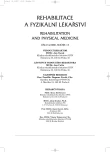Evaluation of Postural Development after the Period of Completed Verticalization
Authors:
T. Nováková; K. Faladová
Authors‘ workplace:
FTVS UK, katedra fyzioterapie, Praha
vedoucí katedry doc. PaedDr. D. Pavlů, CSc.
Published in:
Rehabil. fyz. Lék., 13, 2006, No. 4, pp. 185-189.
Category:
Original Papers
Overview
In the period after completed verticalization of the child there is no agreement with the evaluation of the level of postural maturity. The postural maturity is especially dominated by maturation of CNS, but its evaluation is difficult due to the motor development at this age, which is already significantly influenced by learning (ensuing from affectivity of the individual and the influence of environment). In the first months after verticalization has been reached, there is a rapid development of postural abilities of the child and it is important to select a suitable way of evaluation for early beginning of suitable therapy in cases, where the dynamics of motor evolution of the child is disturbed. The early therapy is the prerequisite for prevention of the origin of functional and structural disorders of locomotor apparatus originating in the period of increased postural load (e.g. at the beginning of school attendance or aimed locomotor activity).
Key words:
postural development, verticalization, developmental standards, testing systems
Labels
Physiotherapist, university degree Rehabilitation Sports medicineArticle was published in
Rehabilitation & Physical Medicine

2006 Issue 4
Most read in this issue
- Vertebrogenic Complaints and Stabilizing Function of Muscles – Diagnostics
- The Role of Diastasis Recti Abdominis in Genesis of Low Back Pain
- Pain as a Factor Indicating and Limiting Rehabilitation
- Muscle Dysbalance of Cervical Muscles
